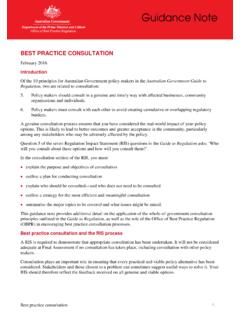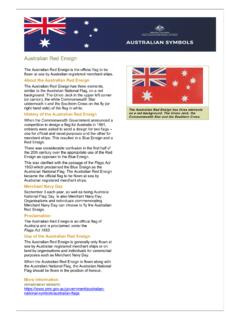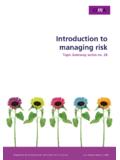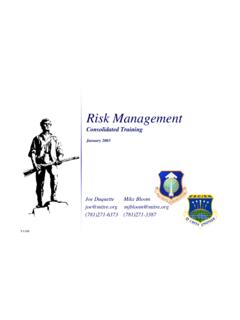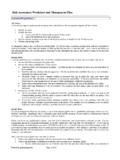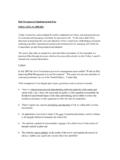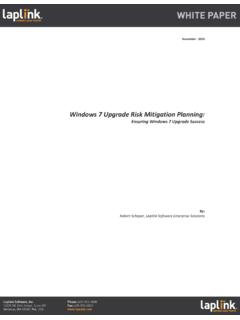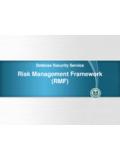Transcription of Implementation Toolkit - 4. Managing risk
1 The Cabinet Implementation Unit within the Department of the Prime Minister and Cabinet provides whole-of-government advice on Implementation and delivery, with a focus on capability building, Implementation assessments and progress reporting. Cabinet Implementation Unit Toolkit 4 Risk Be aware of risks and act early to minimise disruption A positive risk culture is essential. The aim is not to eliminate risk, but rather to have active, ongoing and responsive risk management . Don t allow risk management to fall off the agenda due to time constraints or political demands. Risk management plans should be living documents, and regularly reviewed to reflect current and emerging risks as circumstances change.
2 plan for success by developing the risk management strategy in collaboration with stakeholders and establishing joint ownership of risks . June 2013 2 Elements of effective risk management Risk management is a coordinated set of activities to direct and control an organisation or group with regard to risk. These are the key elements of effective risk management : Develop the risk management plan in collaboration with stakeholders (policy and operational): Involve people with expertise, competency and different skills or backgrounds to ensure that the best available advice informs the risk management plan . Implementation agencies are often better placed than policy agencies to identify Implementation risks , suggest treatment strategies, and advise on risk tolerances.
3 Establish clear ownership of risks : Implementation planning should outline who is responsible for treating or escalating risks , in line with the governance structure. Categorising risks as strategic, operational or compliance may help determine who in the governance structure will have responsibility. Identify risks early: Addressing risk requires early identification and a clear escalation pathway to the appropriate decision maker. This pathway needs to be established, agreed and, importantly, tested through risk examples to make sure it is effective. Consider both operational and strategic risks : Risk planning, mitigation and management must be balanced across risks at both the operational and strategic levels.
4 Skilful risk management is required to meet the urgent needs of operational risks versus the longer-term risks to policy outcomes. The best way to manage whole-of -package strategic risks is to have everyone involved with Implementation jointly identify risks to the initiative. Definitions Risk: the effect of uncertainty on objectives. Issue: a risk that has eventuated. Risk treatment: a process to modify risk. Risk management : a coordinated set of activities to direct and control an organisation or group with regard to risk. Risk escalation: the process of raising risk attention to higher forums/decision-makers. 3 Hurdles to effective risk management Planning for success includes being aware of the hurdles to effective risk management and taking action to avoid or mitigate them.
5 Some of the common hurdles to effective risk management include: Stifling innovation by failing to engage with risk Innovation is critical to new policy Implementation , but trying something new always involves taking risks . Successful risk management is not about avoiding risks ; it involves identifying, assessing and determining appropriate strategies to manage them. Trials (or pilots) and phased Implementation provide opportunities to re-evaluate and reduce risk, and to test and refine management and mitigation strategies. Over-optimism and failure to see emerging risks Risk assessments must not present government and participants with an over-optimistic view.
6 Rather, a good risk plan will take a hard-nosed view and give the full picture. Having a positive risk culture is important. Leaders should ensure that agency culture encourages escalation of risks and that appropriate assistance and support is provided to bring the initiative back on track. Failure to anticipate and manage transmitted risk Some policy changes rely on new or existing non-government providers to deliver services. While this practice is a form of risk sharing, the extent to which risk is distributed can depend on the reliability and clarity of the sharing arrangements. Collaborative development of risk plans is one way to mitigate this problem. However, Australian Government agencies cannot transfer all risks as they have ultimate responsibility for delivering or maintaining service delivery and for implementing contingency plans if risks materialise.
7 Inadequate skills or capability to manage risk Risk management must be undertaken by skilled and senior personnel. If expertise in the Implementation of risk management is inadequate, consider bringing in capable risk managers or sharing the risk (but not the accountability) with outside parties. However risks are managed, the responsibility for them must be formally agreed and acknowledged. Focusing on operational risks at the expense of strategic risks In pressure situations there is a tendency to manage only operational risks , and not strategic risks . This can lead to a situation where the operation was a success but the patient died . That is, all procedures for Managing risks were followed but the intended outcome was not achieved.
8 Operational risks are important: a poorly implemented policy that does not fully consider and track operational Implementation risks may result in failure to achieve the end goal. However, risk managers must understand the risk profile and dependencies of risks across the whole initiative strategic risks to ensure its success. 4 Deprioritising risk management due to time constraints or political demands Engaging with risk management frameworks can fall off the agenda when pressure arises to implement an initiative quickly. Leaders should play an active role in using risk management as a tool for effective delivery. It may also be necessary to brief the chief executive, for possible ministerial attention, on significant risks to Implementation , including appropriate treatments.
9 Focusing mainly on risks of not implementing the initiative rather than Implementation risks Decision-makers need to understand the risks of not implementing an initiative before a decision has been made. Then, however, the emphasis should shift to the risks of implementing the initiative. Strategies for success Effectively Managing the risks associated with your project will ensure its success. Some of the common strategies that will ensure effective risk management are: Start early, and integrate structured risk management methods into your planning Identification, assessment and, ideally, treatment of risks should occur as early as possible during the policy development process.
10 Most agencies have enterprise risk management frameworks based on the best practice guidelines in AS/NZS ISO 31000:2009. The risk management process and risk register are essential elements in the Implementation of a risk management strategy. Setting the context for each risk and the overall risk profile, describing the evidence base (for identification, analysis and evaluation of risk) and describing risk treatments are all important. The commitment or announcement stage is often the point at which risk to government crystallises. This may require policy developers to advise governments about difficulties in the delivery of a proposed initiative in terms of consultation, planning or negotiation.




